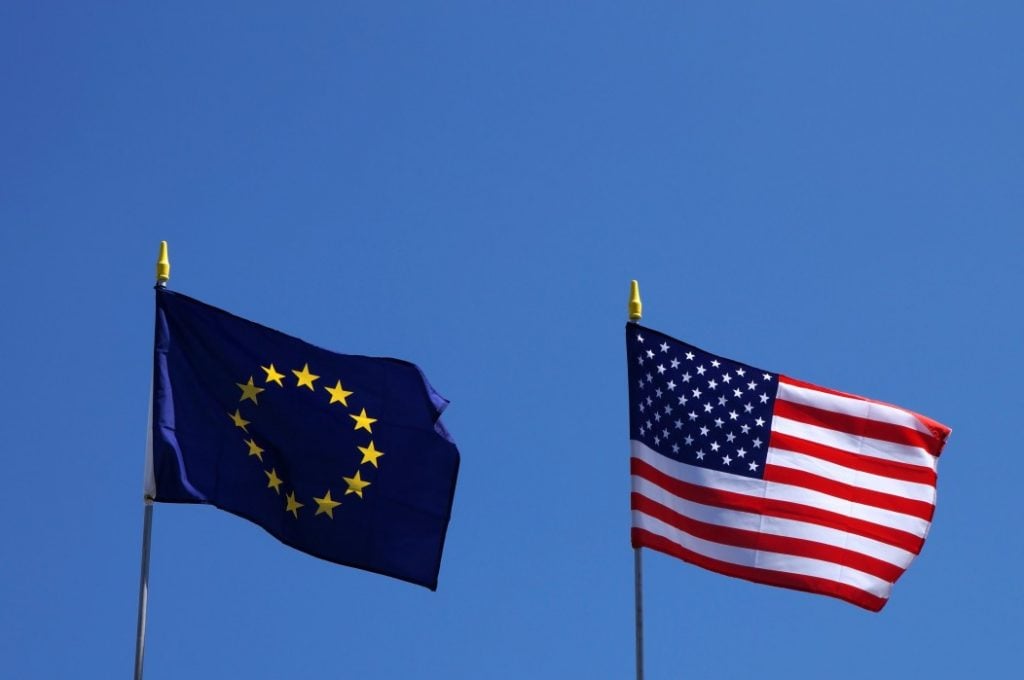Europe Outpaces U.S. in Crypto Banking, But Can It Maintain Its Lead?
11.03.2025 17:30 1 min. read Alexander Stefanov
While the U.S. grapples with crypto regulations, Europe has quietly taken the lead in integrating digital assets into its banking sector.
Over 50 European banks now offer services like custody, trading, and stablecoin transactions, making the continent the most crypto-friendly financial hub.
Circle’s Patrick Hansen highlighted this shift, noting that Europe’s early regulatory clarity—particularly through MiCA—has allowed its banks to establish a strong foundation. Meanwhile, the U.S. is still catching up, with the Office of the Comptroller of the Currency (OCC) only recently permitting banks to provide crypto custody services.
However, Europe’s dominance faces a potential challenge from the U.S., particularly with stablecoins. Pierre Gramegna of the European Stability Mechanism warned that the rise of dollar-backed stablecoins could weaken Europe’s monetary influence, especially if major tech firms integrate them into global payment networks.
Despite these concerns, European banks continue to push forward, benefiting from years of regulatory preparation. With a growing number of institutions embracing crypto, Europe remains ahead in bridging traditional finance with digital assets.
-
1
Fiserv to Launch FIUSD Stablecoin Across Its Massive Banking Network
23.06.2025 21:00 1 min. read -
2
Mastercard Integrates Chainlink to Power Direct Crypto Access for Cardholders
25.06.2025 18:00 1 min. read -
3
BIS Slams Stablecoins, Calls Them Ill-Suited for Modern Monetary Systems
26.06.2025 9:00 1 min. read -
4
Robinhood to Launch Tokenized Shares of OpenAI and SpaceX for European Users
01.07.2025 11:00 2 min. read -
5
Robinhood Expands Crypto Futures With XRP and Solana Micro Contracts
28.06.2025 13:00 2 min. read
Trump Imposes 50% Tariff on Brazil: Political Tensions and Censorship at the Center
President Donald Trump announced a sweeping 50% tariff on Brazilian imports, citing political persecution of former President Jair Bolsonaro and rising concerns over digital censorship.
Binance CEO Issues Urgent Crypto Security Reminder
As cryptocurrency adoption accelerates worldwide, so too does the frequency and sophistication of online threats. Richard Teng, CEO of Binance, has sounded a clear warning: the safety of digital assets hinges not just on exchange security but also on individual user responsibility.
Ripple Selects BNY Mellon as Custodian for RLUSD Stablecoin Reserves
Ripple has chosen global banking giant BNY Mellon to act as the primary custodian for reserves backing its enterprise-grade stablecoin, Ripple USD (RLUSD).
Emirates to Integrate Crypto.com Pay in 2025: A New Era of Airline Payments
Emirates Airline has taken a bold step toward embracing digital finance by signing a Memorandum of Understanding (MoU) with leading cryptocurrency platform Crypto.com.
-
1
Fiserv to Launch FIUSD Stablecoin Across Its Massive Banking Network
23.06.2025 21:00 1 min. read -
2
Mastercard Integrates Chainlink to Power Direct Crypto Access for Cardholders
25.06.2025 18:00 1 min. read -
3
BIS Slams Stablecoins, Calls Them Ill-Suited for Modern Monetary Systems
26.06.2025 9:00 1 min. read -
4
Robinhood to Launch Tokenized Shares of OpenAI and SpaceX for European Users
01.07.2025 11:00 2 min. read -
5
Robinhood Expands Crypto Futures With XRP and Solana Micro Contracts
28.06.2025 13:00 2 min. read


